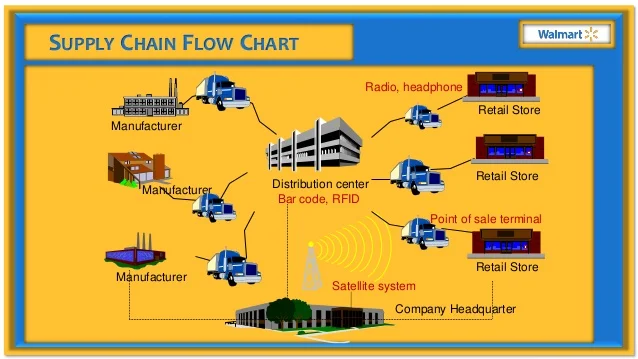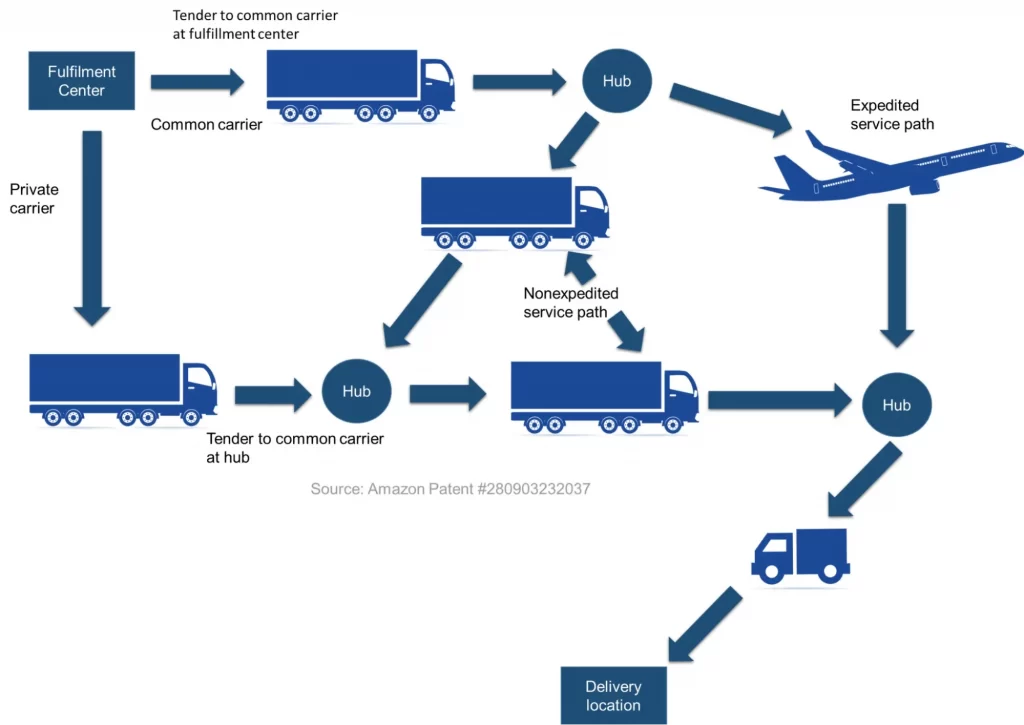Today, customers expect a convenient and seamless shopping experience, regardless of the channel they choose. This has led to the rise of multichannel distribution, where businesses sell their products through multiple channels like online stores, brick-and-mortar locations, mobile apps, and social media platforms.
A well-defined multichannel distribution strategy allows you to cater to diverse customer preferences and maximize sales. Here are 6 effective multichannel distribution strategies that you should try:
- Identifying target customer segments
- Ensuring consistency in branding and messaging
- Developing an inventory management system
- Optimizing your supply chain
- Integrating technology solutions
- Monitoring and analyzing performance
Now, we will go into details!
What is Multichannel Distribution?
Multichannel distribution involves leveraging a combination of direct and indirect channels to sell items or services to customers. Instead of relying on a single method, businesses create a network of channels that cater to different customer preferences and shopping habits.
The key purpose of multichannel distribution is to meet customers wherever they are and however, they prefer to shop.
To illustrate the concept of a multichannel distribution system, here is a practical example:
Dollar Shave Club (DSC) wasn’t just disrupting the men’s grooming industry online, they were shaking things up everywhere. Their quirky online marketing, featuring hilarious video ads, and convenient razor subscription model were a recipe for success.
But DSC knew it wasn’t a one-size-fits-all approach. While building a strong social media presence, they strategically partnered with select brick-and-mortar retailers to expand their reach. This multi-channel approach allowed them to capture both audiences: those who thrived on the ease of online subscriptions and those who preferred the in-store experience before committing.

Master Multichannel Selling with LitCommerce
Discover the simplicity of managing all your sales channels in one central hub with LitCommerce. Say goodbye to manual updates and hello to automation!
6 Effective Multichannel Distribution Strategies
As we mentioned at the beginning, there are 6 key multichannel distributions that help you improve your business. Now, we will go deeper into each strategy. But first, we want to say that identifying your target customer should be the most important of these 6 strategies. It ensures you’re building your distribution strategy on a solid foundation of customer insights, ultimately leading to a more effective and impactful approach.
1. Identifying target customers to choose the right channels
Understanding your target audience is the foundation of any successful multichannel distribution strategy. Segmenting your customer base helps you to tailor your approach to resonate with specific groups. This involves considering factors like demographics, purchase behavior, and online activity.
Implementation tips
Here’s how to get started with finding the right target customer:
- Market research: Conduct surveys and focus groups, and analyze social media data to gather insights into customer demographics, preferences, and buying behavior.
- Market segmentation: Divide your customer base into distinct groups based on characteristics like age, location, buying patterns, and interests. This allows you to tailor your approach for maximum impact.
- Customer profiles: Develop detailed profiles for each segment. Include their needs, pain points, and the channels they frequent. This comprehensive picture guides your channel selection and messaging strategies.
Case study

Glossier, a beauty brand known for its millennial pink aesthetic, exemplifies the power of understanding your target audience as a multichannel distribution strategy. Their success hinges on recognizing their core customer: a social media-savvy individual drawn to trendy and visually appealing products.
Glossier’s products have captured the attention of countless customers on digital platforms thanks to their highly “Instagrammable” nature. They also have 2.6M followers on Instagram who act as brand advocates and generate word-of-mouth sales. Thus, Glossier takes advantage of Instagram as its distribution channel. They sell through Instagram Shopping and affiliate links in UGC content.
Glossier’s physical stores are an extension of their digital strategy. Each location boasts a unique, “Instagrammable” design, further encouraging photo sharing and brand buzz. This in-store experience isn’t just about aesthetics; it’s a carefully curated environment that entices customers to explore and ultimately purchase products.
2. Ensuring consistency in branding and messaging
Consistency in branding and messaging across multichannel distribution builds trust and reinforces brand identity. It ensures that customers receive the same experience, regardless of their chosen channel.
Implementation steps:
Here’s how to ensure consistency:
- Brand guidelines: Develop comprehensive brand guidelines that cover logo usage, color schemes, tone of voice, and key messaging. These guidelines guarantee a consistent brand experience across all touchpoints.
- Team training: Train your internal team and external partners on the brand guidelines to guarantee consistent brand representation.
- Regular audits: Conduct regular audits of all marketing materials, social media presence, and physical stores to identify and address any inconsistencies.
Case study

Allbirds is known for its focus on comfort, sustainability, and minimalist design. This reputation is a direct result of its consistent messaging, which has been a key pillar of its multichannel distribution strategy and a major contributor to its success.
Allbirds’ marketing, social media, website content, and even product packaging all emphasize their core values of comfort, simplicity, and sustainability. This repetition reinforces their brand identity and makes their value proposition clear across all channels:
- Website: High-quality product images and detailed descriptions with a focus on comfort and sustainability are key aspects of their website.
- Social media: Allbirds’ social media presence showcases its products in a lifestyle context while highlighting its commitment to sustainable practices. It uses humor and user-generated content to create a sense of community.
- Physical stores: Their physical stores are designed with a focus on natural materials as well as a minimalist aesthetic, reflecting their brand identity. The shopping experience emphasizes product trial and customer interaction.
3. Developing an inventory management system
A smooth-running multichannel distribution strategy relies heavily on a robust inventory management system. This system ensures you have the right products in the right quantities at the right channel, preventing stockouts and maximizing sales opportunities.
Implementation tips
Here’s how to achieve optimal inventory management on multichannel distribution :
- Centralized inventory management: Unify your inventory data across all channels. Cloud-based inventory management software provides a real-time view of stock levels across your online store, physical locations, and warehouses. This eliminates discrepancies and allows for informed decisions on restocking and fulfilling orders.
- Demand forecasting: Utilize historical sales data and market trends to predict future demand for each item across different channels. This helps you avoid overstocking or understocking, ensuring optimal inventory levels. Tools like machine learning algorithms can be integrated into your inventory management system to automate demand forecasting.
- ABC analysis: Classify your inventory using the ABC analysis method. This categorizes products based on their value and sales volume. “A” items are high-value, fast-selling products requiring stricter control. “B” items are moderate, while “C” items are low-value, slow-moving products. Allocate resources accordingly, focusing on maintaining sufficient stock of “A” items while implementing leaner inventory management for “C” items.
Case study

Walmart, the global retail giant, has successfully implemented an advanced inventory management system as one of their multichannel distribution strategies. They use RFID technology to track inventory in real-time. This system allows Walmart to maintain optimal stock levels, reduce shrinkage, and improve supply chain efficiency.
The result is a well-oiled distribution machine that ensures products are always available to customers, whether they shop in-store or online.
4. Optimize your supply chain
A well-oiled supply chain is critical for delivering products to customers efficiently across multiple channels.
Implementation tips
Here are some key strategies for the optimization supply chain on multichannel distribution:
- Supplier relationships: Build strong relationships with your suppliers to ensure reliable delivery schedules and consistent product quality. Negotiate bulk purchase discounts and flexible payment terms to streamline costs and improve cash flow.
- Warehouse management: Optimize warehouse layouts for efficient product picking, packing, and shipping. Implement technology solutions like warehouse management systems (WMS) to automate processes, minimize errors, and expedite order fulfillment.
- Multimodal transportation: Utilize a combination of shipping methods (air, sea, ground) depending on the urgency and cost requirements of each order. This ensures a balance between speed and cost-effectiveness for your deliveries.
- Dropshipping: Consider dropshipping arrangements for specific products with limited demand. This reduces your storage needs and allows you to offer a wider product variety without carrying additional inventory.
Case study

Amazon is renowned for its highly optimized supply chain. The firm uses sophisticated algorithms and data analytics to forecast demand and manage inventory. They employ a combination of centralized and decentralized distribution centers strategically located to ensure fast delivery.
Amazon’s use of robotics in warehouses and its investment in a fleet of delivery drones and electric vans further enhance its supply chain efficiency. The result is a system that supports their promise of rapid delivery, often within a day, setting a high standard in e-commerce.
5. Integrating technology solutions
Technology is the cornerstone of a smooth-running multichannel distribution system. By strategically implementing the right tools, you can transform a complex network into a well-oiled machine, boosting efficiency and customer satisfaction.
Implementation tips
Here are some key ways to leverage technology:
- Order management systems (OMS): Implement an OMS to manage orders across all channels. This system centralizes order fulfillment, tracking inventory levels, updating order statuses, and automating shipping notifications, creating a seamless customer experience.
- Customer relationship management (CRM) Systems: Utilize a CRM to gather customer data across channels. Analyze purchasing behavior and preferences to personalize marketing efforts and product recommendations. This fosters customer loyalty and drives repeat business.
- Marketing automation tools: Automate marketing campaigns across various channels to reach target audiences effectively. Utilize email marketing tools for targeted promotions and social media scheduling platforms to maintain consistent brand messaging on all platforms.
Case study

Beauty retailer Sephora exemplifies successful technology integration in their multichannel distribution strategy:
- Unified order management: They leverage an OMS that provides a unified view of customer orders across their online store, mobile app, and physical stores. This empowers them to fulfill orders efficiently, allowing customers to buy online and pick up in-store (BOPIS) or vice versa.
- Personalized customer engagement: Sephora utilizes a sophisticated CRM system that tracks customer purchase history and preferences. This enables them to personalize email campaigns with targeted product recommendations, driving customer engagement and sales.
Manage Orders from All Sales Channels Centrally
LitCommerce helps you manage orders from all sales channels in just ONE dashboard. Viewing, managing, and fulfilling orders have never been easier with us!
6. Monitoring and analyzing performance
Continuously monitoring and analyzing the performance of your multichannel distribution strategy is essential for ongoing optimization.
Implementation tips:
Here’s how to stay ahead of the curve:
- Key performance indicators (KPIs): Identify and track relevant KPIs such as order fulfillment time, inventory accuracy, shipping costs, and customer satisfaction ratings. Regularly analyze this data to identify areas for improvement.
- Sales & inventory reports: Utilize sales and inventory reports to identify trends and patterns. Analyze which products sell best on which channels and adjust stocking levels accordingly. This helps optimize product availability and prevent stockouts.
- Customer feedback: Actively solicit customer feedback through surveys and reviews. Analyze this data to understand customer preferences and identify any pain points in the multichannel experience. Address negative feedback promptly and implement improvements based on customer insights.
Case study

Eyewear brand Warby Parker demonstrates the power of data-driven decision-making in a multichannel distribution system. They closely monitor KPIs like conversion rates and customer acquisition costs across their online store and physical locations. This data helps them optimize their marketing campaigns and store layout for maximum impact.
They also actively solicit customer feedback through surveys and reviews. By analyzing this data, Warby Parker has identified a strong customer preference for their try-on-at-home program and has strategically expanded this offering to cater to customer needs.
Benefits and Challenges of Multichannel Distribution
Multichannel distribution offers a powerful strategy to achieve these goals. However, it also presents its own set of challenges that need to be addressed.
Benefits of multichannel distribution
A multichannel distribution system offers a powerful approach for businesses to reach new customers, improve the shopping experience, enhance brand visibility, etc, and ultimately drive sales. Here’s a breakdown of the key advantages:
- Increased market reach: By offering your products through various channels, you reach customers who might not have otherwise discovered your brand. An online store caters to a global audience, while a physical store attracts local customers. Social media marketing allows you to tap into specific demographics interested in your products. This multi-pronged approach helps you reach a wider audience and drive sales growth.
- Improved brand visibility: By having a presence across multichannel distribution, you increase your brand’s visibility and build stronger brand awareness. Consistent messaging and branding across all touchpoints reinforce your brand identity and establish you as a reputable and trustworthy business.
- Diversified risk: Relying solely on one channel leaves your business vulnerable to disruptions. For example, if a major online marketplace experiences technical difficulties, your sales could be negatively affected. Multichannel distribution mitigates this risk by providing alternative sales channels. Even if one channel faces challenges, you can still reach customers through others.
- Data-driven Insights: As customers interact across various channels, you gain access to a wealth of data on their behavior and preferences. This data can be used to personalize marketing campaigns, tailor product offerings to specific channels, and optimize your overall distribution strategy for maximum impact.
Challenges of multichannel distribution
While multichannel distribution offers a plethora of benefits, it’s not without its own set of hurdles. Here’s a closer look at the key challenges businesses need to navigate:
- Increased complexity and management: Gone are the days of simple operations. Managing multiple channels necessitates a well-coordinated effort. You must streamline logistics, inventory, and sales processes across different platforms. This requires robust systems, clear communication between departments, and significant resources.
- Higher operational costs: While multichannel distribution can boost revenue, it also comes with increased operational costs. Maintaining multiple sales channels requires investments in several areas:
- Technology: Advanced inventory management systems are crucial for tracking stock levels across various platforms and preventing overselling or understocking.
- Infrastructure: Upgrading your logistics network might be necessary to ensure efficient delivery across different channels.
- Staffing: Hiring specialized personnel with expertise in managing specific channels (e.g., social media marketing) may be required.
These expenses can strain resources, particularly for smaller businesses with limited budgets. Careful planning and cost analysis are essential before diving into a multichannel approach.
- Potential for channel conflict: When different sales channels compete against each other, it can lead to friction and reduced overall performance. Imagine online sales cannibalizing in-store sales, or direct sales efforts undermining the efforts of your channel partners (distributors, resellers).
Insider tips: Discover deeper insights into the pros and cons of multichannel by exploring the article ” Multichannel vs Omnichannel: What Are the Key Differences?“
Multichannel Distribution: FAQs
Omnichannel and multichannel distribution both involve reaching customers through multiple channels, but with a key difference. Multichannel acts like separate roads leading to the business. Omnichannel creates a seamless journey, integrating all channels (online store, physical stores, mobile app) so the customer experience flows smoothly no matter which touchpoint they use. Multi-level distribution, also known as multi-level marketing (MLM), is a business model where products are sold through a network of independent distributors. Distributors earn commissions on their sales and can also recruit others to build their downline, earning commissions on their sales as well. For example, a retail business might employ a multi-channel strategy by selling products both online through an eCommerce website and in physical stores. Additionally, they may use social media, email marketing, and mobile apps to engage with customers, provide support, and promote products. This approach ensures a broader reach, catering to different customer preferences, and enhancing the overall shopping experience by providing multiple touchpoints for interaction.
Multichannel Distribution and Our Racap!
This article explored six effective multichannel distribution strategies that businesses can leverage to reach a wider audience, improve customer experience, and ultimately drive sales. Here’s a quick recap of the key takeaways:
- Understanding your ideal customer is crucial for selecting the right channels and tailoring your approach for maximum impact.
- A cohesive brand experience across all channels builds trust and reinforces brand identity.
- A robust system ensures that the right products are in stock at the right place, preventing stockouts and maximizing sales opportunities.
- A well-oiled supply chain is essential for efficient product delivery across multiple channels.
- The right technology tools can streamline operations, personalize the customer experience, and boost efficiency.
- Continuously track KPIs, analyze data, and solicit customer feedback to identify areas for improvement and optimize your multichannel strategy.
Finally, stay ahead of the curve! Follow our blog for the latest eCommerce news and insights to help you thrive in the digital marketplace. We’re also happy to answer any questions you may have, so don’t hesitate to contact us.




